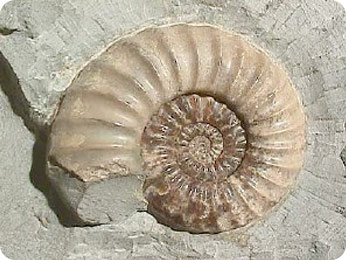 Ammonites can be used as index fossils. Credit: Wikipedia
Ammonites can be used as index fossils. Credit: WikipediaAmmonites lived during the Paleozoic and Mesozoic eras, from about 400 million years ago to 65 million years ago. Along with other fossilized creatures, their presence in layers of rock shows where ancient seas covered the earth. Because they were so widespread and evolved so many different forms rather rapidly, ammonites can also act as “index fossils” to determine the age of rock layers. Scientists can examine the features of an ammonite shell to determine when that animal appeared in the course of ammonite evolution, and thus how long ago it lived. Finding the same species of ammonite in rocks from different places indicates that the rocks are the same age, even if they are located hundreds or thousands of miles apart. Many species are only found in rocks from specific periods of time. In this way, ammonite fossils serve as “time keepers” - and have more than just beauty to offer.


